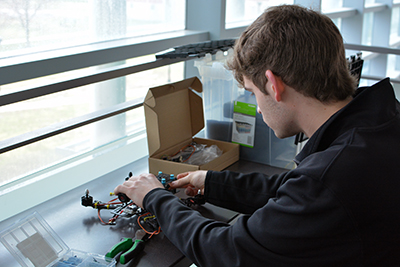Capitol has taken a step to close that
gap by launching a new course that brings together students in two of
the university’s flagship programs – astronautical engineering and
cybersecurity.
 As
part of the course, which is focused on simulation and modelling,
students learn how to operate drones – and infiltrate them via security
holes. Student teams engage in competitive exercises that require them
not only to test their drone flying skills, but to apply their knowledge
of drone vulnerabilities to hack their competitors.
As
part of the course, which is focused on simulation and modelling,
students learn how to operate drones – and infiltrate them via security
holes. Student teams engage in competitive exercises that require them
not only to test their drone flying skills, but to apply their knowledge
of drone vulnerabilities to hack their competitors.
In another course segment, students use modelling to devise strategies for drone-based disaster relief in scenarios such as the 2016 Ellicott City floods. While planning and executing the disaster relief, they must deal with adversaries intent on sabotaging the efforts.
“The idea with this course is that half the students are going to come from a cyber major, and the other half from astronautical or electrical engineering,” explains astronautical engineering professor Dr. Sandy Antunes, who co-teaches the course together with cybersecurity professor Rick Hansen. “One group is going to know the hardware but not how to secure it, and the other group’s going to know how to secure it, but not the hardware. We do some IA material and some AE material, and we do a lot of hands on.”
“When you go out to work, you need to be comfortable outside of your niche,” Antunes notes. “If you’re a hardware person, then you need to know a little about software and about security. If you’re a software security person you need to know about the hardware assets and the operational environment.”
Antunes says the university is committed to providing more courses of this nature and cross-listing them across programs. Doing so allows students to complete their major requirements while also interacting with other fields.
“We have students who really want to go outside their discipline,” Antunes says. “Our goal is to provide an opportunity for them. It’s not a neat academic exercise; it’s what people hire.”
“Companies like General Dynamics and Orbital come to us and say ‘wow, your students are out interacting with people from other majors. We didn’t do that until we hit the workforce.’ The career market is faster-paced now; our graduates don’t have time to slowly ramp up in jobs,” he says.
Goto: http://bit.ly/2rHlrb6
 As
part of the course, which is focused on simulation and modelling,
students learn how to operate drones – and infiltrate them via security
holes. Student teams engage in competitive exercises that require them
not only to test their drone flying skills, but to apply their knowledge
of drone vulnerabilities to hack their competitors.
As
part of the course, which is focused on simulation and modelling,
students learn how to operate drones – and infiltrate them via security
holes. Student teams engage in competitive exercises that require them
not only to test their drone flying skills, but to apply their knowledge
of drone vulnerabilities to hack their competitors.In another course segment, students use modelling to devise strategies for drone-based disaster relief in scenarios such as the 2016 Ellicott City floods. While planning and executing the disaster relief, they must deal with adversaries intent on sabotaging the efforts.
“The idea with this course is that half the students are going to come from a cyber major, and the other half from astronautical or electrical engineering,” explains astronautical engineering professor Dr. Sandy Antunes, who co-teaches the course together with cybersecurity professor Rick Hansen. “One group is going to know the hardware but not how to secure it, and the other group’s going to know how to secure it, but not the hardware. We do some IA material and some AE material, and we do a lot of hands on.”
“When you go out to work, you need to be comfortable outside of your niche,” Antunes notes. “If you’re a hardware person, then you need to know a little about software and about security. If you’re a software security person you need to know about the hardware assets and the operational environment.”
Antunes says the university is committed to providing more courses of this nature and cross-listing them across programs. Doing so allows students to complete their major requirements while also interacting with other fields.
“We have students who really want to go outside their discipline,” Antunes says. “Our goal is to provide an opportunity for them. It’s not a neat academic exercise; it’s what people hire.”
“Companies like General Dynamics and Orbital come to us and say ‘wow, your students are out interacting with people from other majors. We didn’t do that until we hit the workforce.’ The career market is faster-paced now; our graduates don’t have time to slowly ramp up in jobs,” he says.
Goto: http://bit.ly/2rHlrb6
No comments:
Post a Comment